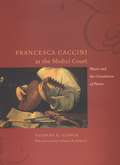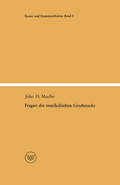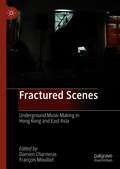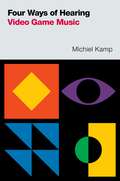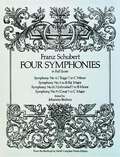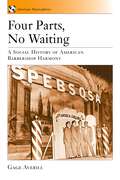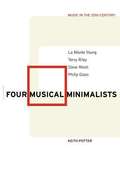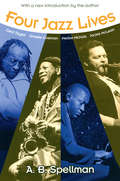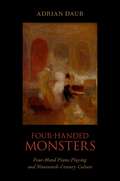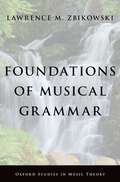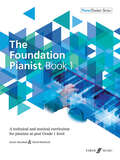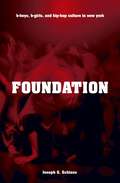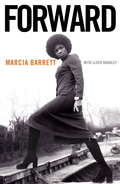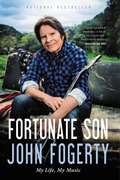- Table View
- List View
Francesca Caccini at the Medici Court: Music and the Circulation of Power (Women in Culture and Society)
by Suzanne G. CusickA contemporary of Shakespeare and Monteverdi, and a colleague of Galileo and Artemisia Gentileschi at the Medici court, Francesca Caccini was a dominant musical figure there for thirty years. Dazzling listeners with the transformative power of her performances and the sparkling wit of the music she composed for more than a dozen court theatricals, Caccini is best remembered today as the first woman to have composed opera. Francesca Caccini at the Medici Court reveals for the first time how this multitalented composer established a fully professional musical career at a time when virtually no other women were able to achieve comparable success. Suzanne G. Cusick argues that Caccini’s career depended on the usefulness of her talents to the political agenda of Grand Duchess Christine de Lorraine, Tuscany’s de facto regent from 1606 to 1636. Drawing on Classical and feminist theory, Cusick shows how the music Caccini made for the Medici court sustained the culture that enabled Christine’s power, thereby also supporting the sexual and political aims of its women. In bringing Caccini’s surprising story so vividly to life, Cusick ultimately illuminates how music making functioned in early modern Italy as a significant medium for the circulation of power.
Fragen des musikalischen Geschmacks: Eine musiksoziologische Studie (Kunst und Kommunikation #8)
by John Henry MuellerFractured Scenes: Underground Music-Making in Hong Kong and East Asia
by Damien Charrieras François MouillotFractured Scenes is the first extensive academic account of music and sound art practices that fall outside of the scope of ‘mainstream music’ in Hong Kong. It combines academic essays with original interviews conducted with prominent Hong Kong underground/independent musicians and sound artists as well as first hand-accounts by key local scene actors in order to survey genres such as experimental/noise music, deconstructed electronic music, indie-pop, punk, garage rock, sound art and DIY ‘computer’ music (among others). It examines these Hong Kong underground music practices in relief with specific case studies in Mainland China and Japan to begin re-defining the notion of a ‘musical underground’ in the context of contemporary Hong Kong.
Four Ways of Hearing Video Game Music (Oxford Music / Media)
by Michiel KampFour Ways of Hearing Video Game Music offers a novel account of the ways in which video games invite us to hear and listen to their music. By taking a phenomenological approach to characterize music in video games, author Michiel Kamp asks what it is we hear in the music when we play a game. Drawing on past phenomenological approaches to music as well as studies of music listening in a variety of disciplines such as aesthetics and ecological psychology, Kamp explains four main ways of hearing the same piece of music--through background, aesthetic, ludic, and semiotic hearing. As a background, music is not attended to at all, but can still be described in terms of moods, affordances, or equipment. Aesthetic hearing is a reflective attitude that invites hermeneutic interpretation; ludic hearing on the other hand invites "playing along" to the music, either through embodied movement, or in response to the music's cinematic or theatrical connotations. Finally, in semiotic hearing, Kamp argues that we hear music as transparent symbols or signals that provide information about the state of a game. The book investigates these four categories through detailed case studies of video games from a variety of eras and genres accompanied by gameplay recordings and images on a companion website.
Four Ways of Hearing Video Game Music (Oxford Music / Media)
by Michiel KampFour Ways of Hearing Video Game Music offers a novel account of the ways in which video games invite us to hear and listen to their music. By taking a phenomenological approach to characterize music in video games, author Michiel Kamp asks what it is we hear in the music when we play a game. Drawing on past phenomenological approaches to music as well as studies of music listening in a variety of disciplines such as aesthetics and ecological psychology, Kamp explains four main ways of hearing the same piece of music--through background, aesthetic, ludic, and semiotic hearing. As a background, music is not attended to at all, but can still be described in terms of moods, affordances, or equipment. Aesthetic hearing is a reflective attitude that invites hermeneutic interpretation; ludic hearing on the other hand invites "playing along" to the music, either through embodied movement, or in response to the music's cinematic or theatrical connotations. Finally, in semiotic hearing, Kamp argues that we hear music as transparent symbols or signals that provide information about the state of a game. The book investigates these four categories through detailed case studies of video games from a variety of eras and genres accompanied by gameplay recordings and images on a companion website.
Four Symphonies: In Full Score
by Franz SchubertIn 1978 the music world commemorated the 150th anniversary of Schubert's death, and his great symphonies were widely played and recorded. In this one volume are Schubert's four most popular and most often played symphonies in full score, including the Symphony No. 9, which, according to Grove's Dictionary, is "universally admitted to be his greatest masterpiece." The symphonies are reproduced complete and unabridged from the famous and scholarly Breitkopf & Härtel series, a large and eminently readable edition, and are edited by Brahms. No other single-volume edition of these works is currently available.Included in this book are:Symphony No. 4 ("Tragic") in C MinorSymphony No. 5 in B-flat Major (also known as "Symphony without Trumpets and Drums")Symphony No. 8 ("Unfinished) in B MinorSymphony No. 9 ("Great) in C MajorThe music has been reproduced in a size large enough to be read easily, with large noteheads, wide margins (for notes, annotations, etc.), and on opaque paper with sturdy, sewn bindings. Pages lie flat and will not fall out. The edition is practical for almost any use, whether as a study guide, a reference, or simply a companion for your greater musical enjoyment.
Four Parts, No Waiting: A Social History of American Barbershop Quartet (American Musicspheres #1)
by Gage AverillFour Parts, No Waiting investigates the role that vernacular, barbershop-style close harmony has played in American musical history, in American life, and in the American imagination. Starting with a discussion of the first craze for Austrian four-part close harmony in the 1830s, Averill traces the popularity of this musical form in minstrel shows, black recreational singing, vaudeville, early recordings, and in the barbershop revival of the 1930s. In his exploration of barbershop, Averill uncovers a rich musical tradition--a hybrid of black and white cultural forms, practiced by amateurs, and part of a mythologized vision of small-town American life. Barbershop harmony played a central -- and overlooked -- role in the panorama of American music. Averill demonstrates that the barbershop revival was part of a depression-era neo-Victorian revival, spurred on by insecurities of economic and social change. Contemporary barbershop singing turns this nostalgic vision into lived experience. Arguing that the "old songs" function as repositories of idealized social memory, Averill reveals ideologies of gender, race, and class. This engagingly-written, often funny book critiques the nostalgic myths (especially racial myths) that have surrounded the barbershop revival, but also celebrates the civic-minded, participatory spirit of barbershop harmony. The contents of the CD have been replaced by a companion website with helpful links, resources, and audio examples.
Four Musical Minimalists: La Monte Young, Terry Riley, Steve Reich, Philip Glass (PDF)
by Keith PotterThe American composers la Monte Young, Terry Riley, Steve Reich and Philip Glass are widely regarded as pioneers of the aesthetic and the techniques of minimalism in musical composition during the 1960s and early 1970s. This book offers the most detailed account so far of their early works, putting extensive discussion of the music into a biographical perspective. The true musical minimalism of these years is placed in the wider context of their music as a whole, and considered within the cultural conditions of the period which saw not only the rise of minimalism in the fine arts but also crucial changes in the theory and practice of musical composition in the Western cultivated tradition.
Four Last Songs: Aging and Creativity in Verdi, Strauss, Messiaen, and Britten
by Linda Hutcheon Michael HutcheonAging and creativity can seem a particularly fraught relationship for artists, who often face age-related difficulties as their audience’s expectations are at a peak. In Four Last Songs, Linda and Michael Hutcheon explore this issue via the late works of some of the world’s greatest composers. Giuseppe Verdi (1813–1901), Richard Strauss (1864–1949), Olivier Messiaen (1908–92), and Benjamin Britten (1913–76) all wrote operas late in life, pieces that reveal unique responses to the challenges of growing older. Verdi’s Falstaff, his only comedic success, combated Richard Wagner’s influence by introducing young Italian composers to a new model of national music. Strauss, on the other hand, struggling with personal and political problems in Nazi Germany, composed the self-reflexive Capriccio, a “life review” of opera and his own legacy. Though it exhausted him physically and emotionally, Messiaen at the age of seventy-five finished his only opera, Saint François d’Assise, which marked the pinnacle of his career. Britten, meanwhile, suffering from heart problems, refused surgery until he had completed his masterpiece, Death in Venice. For all four composers, age, far from sapping their creative power, provided impetus for some of their best accomplishments. With its deft treatment of these composers’ final years and works, Four Last Songs provides a valuable look at the challenges—and opportunities—that present themselves as artists grow older.
Four Last Songs: Aging and Creativity in Verdi, Strauss, Messiaen, and Britten
by Linda Hutcheon Michael HutcheonAging and creativity can seem a particularly fraught relationship for artists, who often face age-related difficulties as their audience’s expectations are at a peak. In Four Last Songs, Linda and Michael Hutcheon explore this issue via the late works of some of the world’s greatest composers. Giuseppe Verdi (1813–1901), Richard Strauss (1864–1949), Olivier Messiaen (1908–92), and Benjamin Britten (1913–76) all wrote operas late in life, pieces that reveal unique responses to the challenges of growing older. Verdi’s Falstaff, his only comedic success, combated Richard Wagner’s influence by introducing young Italian composers to a new model of national music. Strauss, on the other hand, struggling with personal and political problems in Nazi Germany, composed the self-reflexive Capriccio, a “life review” of opera and his own legacy. Though it exhausted him physically and emotionally, Messiaen at the age of seventy-five finished his only opera, Saint François d’Assise, which marked the pinnacle of his career. Britten, meanwhile, suffering from heart problems, refused surgery until he had completed his masterpiece, Death in Venice. For all four composers, age, far from sapping their creative power, provided impetus for some of their best accomplishments. With its deft treatment of these composers’ final years and works, Four Last Songs provides a valuable look at the challenges—and opportunities—that present themselves as artists grow older.
Four Last Songs: Aging and Creativity in Verdi, Strauss, Messiaen, and Britten
by Linda Hutcheon Michael HutcheonAging and creativity can seem a particularly fraught relationship for artists, who often face age-related difficulties as their audience’s expectations are at a peak. In Four Last Songs, Linda and Michael Hutcheon explore this issue via the late works of some of the world’s greatest composers. Giuseppe Verdi (1813–1901), Richard Strauss (1864–1949), Olivier Messiaen (1908–92), and Benjamin Britten (1913–76) all wrote operas late in life, pieces that reveal unique responses to the challenges of growing older. Verdi’s Falstaff, his only comedic success, combated Richard Wagner’s influence by introducing young Italian composers to a new model of national music. Strauss, on the other hand, struggling with personal and political problems in Nazi Germany, composed the self-reflexive Capriccio, a “life review” of opera and his own legacy. Though it exhausted him physically and emotionally, Messiaen at the age of seventy-five finished his only opera, Saint François d’Assise, which marked the pinnacle of his career. Britten, meanwhile, suffering from heart problems, refused surgery until he had completed his masterpiece, Death in Venice. For all four composers, age, far from sapping their creative power, provided impetus for some of their best accomplishments. With its deft treatment of these composers’ final years and works, Four Last Songs provides a valuable look at the challenges—and opportunities—that present themselves as artists grow older.
Four Last Songs: Aging and Creativity in Verdi, Strauss, Messiaen, and Britten
by Linda Hutcheon Michael HutcheonAging and creativity can seem a particularly fraught relationship for artists, who often face age-related difficulties as their audience’s expectations are at a peak. In Four Last Songs, Linda and Michael Hutcheon explore this issue via the late works of some of the world’s greatest composers. Giuseppe Verdi (1813–1901), Richard Strauss (1864–1949), Olivier Messiaen (1908–92), and Benjamin Britten (1913–76) all wrote operas late in life, pieces that reveal unique responses to the challenges of growing older. Verdi’s Falstaff, his only comedic success, combated Richard Wagner’s influence by introducing young Italian composers to a new model of national music. Strauss, on the other hand, struggling with personal and political problems in Nazi Germany, composed the self-reflexive Capriccio, a “life review” of opera and his own legacy. Though it exhausted him physically and emotionally, Messiaen at the age of seventy-five finished his only opera, Saint François d’Assise, which marked the pinnacle of his career. Britten, meanwhile, suffering from heart problems, refused surgery until he had completed his masterpiece, Death in Venice. For all four composers, age, far from sapping their creative power, provided impetus for some of their best accomplishments. With its deft treatment of these composers’ final years and works, Four Last Songs provides a valuable look at the challenges—and opportunities—that present themselves as artists grow older.
Four Last Songs: Aging and Creativity in Verdi, Strauss, Messiaen, and Britten
by Linda Hutcheon Michael HutcheonAging and creativity can seem a particularly fraught relationship for artists, who often face age-related difficulties as their audience’s expectations are at a peak. In Four Last Songs, Linda and Michael Hutcheon explore this issue via the late works of some of the world’s greatest composers. Giuseppe Verdi (1813–1901), Richard Strauss (1864–1949), Olivier Messiaen (1908–92), and Benjamin Britten (1913–76) all wrote operas late in life, pieces that reveal unique responses to the challenges of growing older. Verdi’s Falstaff, his only comedic success, combated Richard Wagner’s influence by introducing young Italian composers to a new model of national music. Strauss, on the other hand, struggling with personal and political problems in Nazi Germany, composed the self-reflexive Capriccio, a “life review” of opera and his own legacy. Though it exhausted him physically and emotionally, Messiaen at the age of seventy-five finished his only opera, Saint François d’Assise, which marked the pinnacle of his career. Britten, meanwhile, suffering from heart problems, refused surgery until he had completed his masterpiece, Death in Venice. For all four composers, age, far from sapping their creative power, provided impetus for some of their best accomplishments. With its deft treatment of these composers’ final years and works, Four Last Songs provides a valuable look at the challenges—and opportunities—that present themselves as artists grow older.
Four Last Songs: Aging and Creativity in Verdi, Strauss, Messiaen, and Britten
by Linda Hutcheon Michael HutcheonAging and creativity can seem a particularly fraught relationship for artists, who often face age-related difficulties as their audience’s expectations are at a peak. In Four Last Songs, Linda and Michael Hutcheon explore this issue via the late works of some of the world’s greatest composers. Giuseppe Verdi (1813–1901), Richard Strauss (1864–1949), Olivier Messiaen (1908–92), and Benjamin Britten (1913–76) all wrote operas late in life, pieces that reveal unique responses to the challenges of growing older. Verdi’s Falstaff, his only comedic success, combated Richard Wagner’s influence by introducing young Italian composers to a new model of national music. Strauss, on the other hand, struggling with personal and political problems in Nazi Germany, composed the self-reflexive Capriccio, a “life review” of opera and his own legacy. Though it exhausted him physically and emotionally, Messiaen at the age of seventy-five finished his only opera, Saint François d’Assise, which marked the pinnacle of his career. Britten, meanwhile, suffering from heart problems, refused surgery until he had completed his masterpiece, Death in Venice. For all four composers, age, far from sapping their creative power, provided impetus for some of their best accomplishments. With its deft treatment of these composers’ final years and works, Four Last Songs provides a valuable look at the challenges—and opportunities—that present themselves as artists grow older.
Four Jazz Lives: Four Jazz Lives (Jazz Perspectives)
by A. B. SpellmanReview "Remains the best introduction to the worlds of Cecil Taylor, Ornette Coleman, Herbie Nichols, and Jackie McLean." --Ben Ratliff --Ben Ratliff (10/31/2003) "Four black jazzmen speak at considerable length for themself, with connective passages supplied with persistent relevancy by a poet, historian, and critic." --Nat Hentoff --Nat Hentoff (10/31/2003) "An essential book in the jazz canon. . . . [T]he University of Michigan Press has given it a rebirth under the title Four Jazz Lives." --Nat Hentoff, JazzTimes -- (07/29/2004) "An engrossing, impressionistic history of contemporary jazz." --Nation --Nation (10/31/2003) "[Spellman] views these men with a perceptive and understanding eye." --New York Times --New York Times (10/31/2003) About the Author A. B. Spellman is a well-known author, poet, critic, and instructor. He has published numerous books and articles on the arts, including Art Tatum: A Critical Biography and The Beautiful Days.
Four-Handed Monsters: Four-Hand Piano Playing and Nineteenth-Century Culture
by Adrian DaubIn the course of the nineteenth century, four-hand piano playing emerged across Europe as a popular pastime of the well-heeled classes and of those looking to join them. Nary a canonic work of classical music that was not set for piano duo, nary a house that could afford not to invest in them. Duets echoed from the student bedsit to Buckingham Palace, resounded in schools and in hundreds of thousands of bourgeois parlors. Like no other musical phenomenon, it could cross national, social, and economic boundaries, bringing together poor students with the daughters of the bourgeoisie, crowned heads with penniless virtuosi, and the nineteenth century often regarded it with extreme suspicion for that very reason. Four-hand piano playing was often understood as a socially acceptable way of flirting, a flurry of hands that made touching, often of men and women, not just acceptable but necessary. But it also became something far more serious than that, a central institution of the home, mediating between inside and outside, family and society, labor and leisure, nature and nurture. And writers, composers, musicians, philosophers, journalists, pamphleteers and painters took note: in the art, literature, and philosophy of the age, four-hand playing emerged as a common motif, something that allowed them to interrogate the very nature of the self, the family, the community and the state. In the four hands rushing up and down the same keyboard the nineteenth century espied, or thought to espy, an astonishing array of things. Four-Handed Monsters tells not only the story of that practice, but also the story of the astonishing array of things the nineteenth century read into it.
Four-Handed Monsters: Four-Hand Piano Playing and Nineteenth-Century Culture
by Adrian DaubIn the course of the nineteenth century, four-hand piano playing emerged across Europe as a popular pastime of the well-heeled classes and of those looking to join them. Nary a canonic work of classical music that was not set for piano duo, nary a house that could afford not to invest in them. Duets echoed from the student bedsit to Buckingham Palace, resounded in schools and in hundreds of thousands of bourgeois parlors. Like no other musical phenomenon, it could cross national, social, and economic boundaries, bringing together poor students with the daughters of the bourgeoisie, crowned heads with penniless virtuosi, and the nineteenth century often regarded it with extreme suspicion for that very reason. Four-hand piano playing was often understood as a socially acceptable way of flirting, a flurry of hands that made touching, often of men and women, not just acceptable but necessary. But it also became something far more serious than that, a central institution of the home, mediating between inside and outside, family and society, labor and leisure, nature and nurture. And writers, composers, musicians, philosophers, journalists, pamphleteers and painters took note: in the art, literature, and philosophy of the age, four-hand playing emerged as a common motif, something that allowed them to interrogate the very nature of the self, the family, the community and the state. In the four hands rushing up and down the same keyboard the nineteenth century espied, or thought to espy, an astonishing array of things. Four-Handed Monsters tells not only the story of that practice, but also the story of the astonishing array of things the nineteenth century read into it.
The Foundations of Rock: From "Blue Suede Shoes" to "Suite: Judy Blue Eyes"
by Walter EverettA comprehensive introduction to the inner workings of rock music, The Foundations of Rock goes back to the heart of the music itself from the time of its birth through the end of classic rock. Walter Everett expertly takes readers through all aspects of the music and its lyrics, leading fans and listeners to new insights and new ways to develop their own interpretations of the aural landscapes of their lives. Written with style, Everett does not depend on musical notation nor professional jargon, but rather combines text with nearly 300 newly written audio examples (performed on the companion website) and more than 100 expertly chosen photographs, to offer a rich text-and-web experience that brings new meanings to songs that have dominated music for a half-century. Through careful illustration, frequently citing the most familiar and pertinent examples from throughout the 1955-1970 period, The Foundations of Rock covers the nature and use of all musical instruments and vocal qualities; reveals the many different ways that phrases and sections of songs can be combined; discusses the materials and patterns in melodic, harmonic, and rhythmic invention; explains the many important ways that producers and engineers add to the artistry; and finally suggests paths for combining an understanding of all of these elements with interpretations of a song's lyrics. This is all done in thorough detail, and always with an ear towards the possible meanings such techniques convey in a music that has had a profound impact upon our world. In doing so, Everett helps readers create new depths of understanding and appreciation. Hundreds of memorable hit songs are referred to in order to illustrate every individual point, while twenty-five diverse classics of the period have been chosen for very close hearing from multiple perspectives. The reader will come away with a much deeper appreciation of the music of the Beatles and the Stones, the Supremes and the Temptations, the Dead and Janis, Elvis and Buddy Holly, the Beach Boys and the Rascals.
Foundations of Musical Grammar (Oxford Studies in Music Theory)
by Lawrence M. ZbikowskiIn recent years, music theorists have been increasingly eager to incorporate findings from the science of human cognition and linguistics into their methodology. In the culmination of a vast body of research undertaken since his influential and award-winning Conceptualizing Music (OUP 2002), Lawrence M. Zbikowski puts forward Foundations of Musical Grammar, an ambitious and broadly encompassing account on the foundations of musical grammar based on our current understanding of human cognitive capacities. Musical grammar is conceived of as a species of construction grammar, in which grammatical elements are form-function pairs. Zbikowski proposes that the basic function of music is to provide sonic analogs for dynamic processes that are important in human cultural interactions. He focuses on three such processes: those concerned with the emotions, the spontaneous gestures that accompany speech, and the patterned movement of dance. Throughout the book, Zbikowski connects cognitive research with music theory for an interdisciplinary audience, presenting detailed musical analyses and summaries of the basic elements of musical grammar.
Foundations of Musical Grammar (Oxford Studies in Music Theory)
by Lawrence M. ZbikowskiIn recent years, music theorists have been increasingly eager to incorporate findings from the science of human cognition and linguistics into their methodology. In the culmination of a vast body of research undertaken since his influential and award-winning Conceptualizing Music (OUP 2002), Lawrence M. Zbikowski puts forward Foundations of Musical Grammar, an ambitious and broadly encompassing account on the foundations of musical grammar based on our current understanding of human cognitive capacities. Musical grammar is conceived of as a species of construction grammar, in which grammatical elements are form-function pairs. Zbikowski proposes that the basic function of music is to provide sonic analogs for dynamic processes that are important in human cultural interactions. He focuses on three such processes: those concerned with the emotions, the spontaneous gestures that accompany speech, and the patterned movement of dance. Throughout the book, Zbikowski connects cognitive research with music theory for an interdisciplinary audience, presenting detailed musical analyses and summaries of the basic elements of musical grammar.
The Foundation Pianist Book 1: A Technical and Musical Curriculum for Pianists at Post Grade 1 Level (Faber Edition: Piano Trainer #Bk 1)
by Karen Marshall David BlackwellThe Foundation Pianist is a set of two books by David Blackwell and Karen Marshall for students beyond the beginner stage who want to develop a technical and musical foundation to help them progress on to intermediate levels. Exploring piano technique through a variety of elements, the books include daily exercises, sight-reading, repertoire and musical time travel. This series not only develops students’ technique, reading, theory and musicianship, but also provides an invaluable insight into the world of classical music, from madrigals to symphonies and operas to concertos. The Foundation Pianist Book 1 forms part of the PianoTrainer series.
Foundation: B-boys, B-girls and Hip-Hop Culture in New York
by Joseph G. SchlossB-boying is a form of Afro-diasporic competitive dance that developed in the Bronx, NY in the early 1970s. Widely - though incorrectly - known as "breakdancing," it is often dismissed as a form of urban acrobatics set to music. In reality, however, b-boying is a deeply traditional and profoundly expressive art form that has been passed down from teacher to student for almost four decades. Foundation: B-boys, B-girls and Hip-Hop Culture in New York offers the first serious study of b-boying as both unique dance form and a manifestation of the most fundamental principles of hip-hop culture. Drawing on anthropological and historical research, interviews and personal experience as a student of the dance, Joseph Schloss presents a nuanced picture of b-boying and its social context. From the dance's distinctive musical repertoire and traditional educational approaches to its complex stylistic principles and secret battle strategies, Foundation illuminates a previously unexamined thread in the complex tapestry that is contemporary hip-hop.
Foundation: B-boys, B-girls and Hip-Hop Culture in New York
by Joseph G. SchlossB-boying is a form of Afro-diasporic competitive dance that developed in the Bronx, NY in the early 1970s. Widely - though incorrectly - known as "breakdancing," it is often dismissed as a form of urban acrobatics set to music. In reality, however, b-boying is a deeply traditional and profoundly expressive art form that has been passed down from teacher to student for almost four decades. Foundation: B-boys, B-girls and Hip-Hop Culture in New York offers the first serious study of b-boying as both unique dance form and a manifestation of the most fundamental principles of hip-hop culture. Drawing on anthropological and historical research, interviews and personal experience as a student of the dance, Joseph Schloss presents a nuanced picture of b-boying and its social context. From the dance's distinctive musical repertoire and traditional educational approaches to its complex stylistic principles and secret battle strategies, Foundation illuminates a previously unexamined thread in the complex tapestry that is contemporary hip-hop.
Forward: My Life With and Without Boney M.
by Marcia BarrettComing to London aged thirteen from desperate poverty in Jamaica; pregnant at fifteen; fifteen years later singing in Boney M, one of the biggest international groups of the late-1970s; a messy group split during the 1980s; a 1990s solo career interrupted by six bouts of cancer - ovarian, breast, lymph node (twice), spine and oesophagus - and having to learn to walk again. Yet throughout Marcia Barrett has remained totally cheerful, relentlessly optimistic and a shining inspiration, looking on every obstacle as a mere inconvenience rather than anything insurmountable. Now, she is ready to tell her fantastic story, which is much more than just a pop star autobiography. It is a charming, candid, laugh-out-loud story of survival, triumph, indomitable spirit and total upfullness, often driven by sheer force of will. It is a feelgood story which will resonate amongst all.
Fortunate Son: My Life, My Music
by John FogertyThe long-awaited memoir from John Fogerty, the legendary singer-songwriter and creative force behind Creedence Clearwater Revival. Creedence Clearwater Revival is one of the most important and beloved bands in the history of rock, and John Fogerty wrote, sang, and produced their instantly recognizable classics: "Proud Mary," "Bad Moon Rising," "Born on the Bayou," and more. Now he reveals how he brought CCR to number one in the world, eclipsing even the Beatles in 1969. By the next year, though, Creedence was falling apart; their amazing, enduring success exploded and faded in just a few short years. Fortunate Son takes readers from Fogerty's Northern California roots, through Creedence's success and the retreat from music and public life, to his hard-won revival as a solo artist who finally found love.
